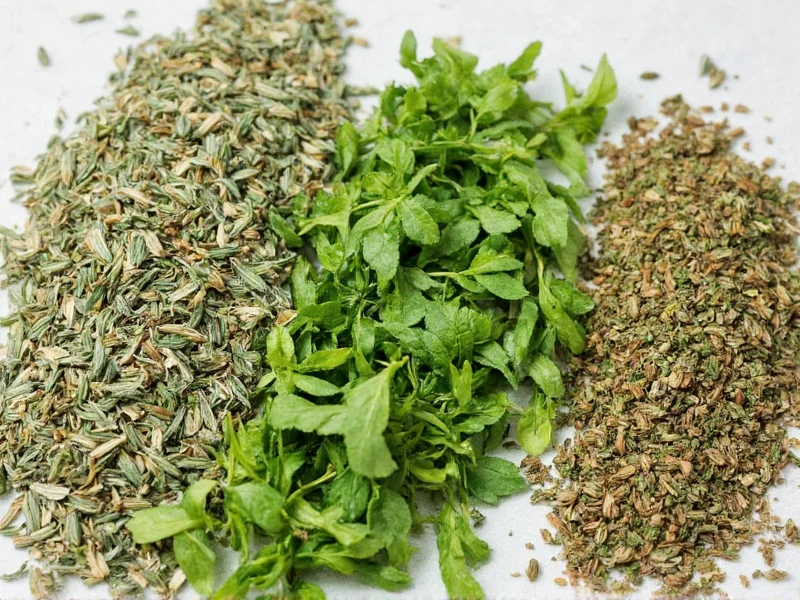Understanding herb conversions is essential for consistent cooking results. When recipes don't specify whether to use dried or fresh herbs, knowing proper substitution ratios prevents flavor imbalances that can ruin dishes. The difference in potency stems from the dehydration process, which concentrates flavors while removing moisture.
The Science Behind Herb Potency Differences
Fresh herbs contain approximately 80-90% water, while dried herbs have most moisture removed. This concentration effect means dried herbs deliver more intense flavor in smaller quantities. The drying process affects different herbs unevenly based on their essential oil content and cellular structure.
Herbs with higher essential oil concentrations, like rosemary and thyme, experience less flavor degradation during drying compared to more delicate varieties such as basil and cilantro. This explains why some herbs maintain closer to a 1:3 ratio while others require adjustments.
Standard Conversion Guidelines
While the 1:3 ratio serves as a reliable starting point, several factors influence precise conversions:
- Herb type - Woody herbs maintain potency better than leafy varieties
- Storage duration - Dried herbs lose potency over time
- Drying method - Sun-dried versus oven-dried affects concentration
- Recipe liquid content - Moist cooking environments rehydrate dried herbs
| Herb | Fresh Measurement | Dried Equivalent | Special Notes |
|---|---|---|---|
| Basil | 1 tablespoon | 1 teaspoon | Use 1:2 ratio for delicate dishes |
| Thyme | 1 tablespoon | 1 teaspoon | Standard 1:3 ratio applies |
| Oregano | 1 tablespoon | 1 teaspoon | Dried oregano often preferred for intensity |
| Rosemary | 1 tablespoon | 1 teaspoon | Crush dried rosemary before use |
| Cilantro | 2 tablespoons | 1 teaspoon | Fresh preferred; dried loses distinctive flavor |
| Dill | 1.5 tablespoons | 1 teaspoon | Fresh dill more floral; dried more earthy |
| Mint | 2 tablespoons | 1 teaspoon | Use less dried mint to avoid medicinal flavor |
| Tarragon | 1.5 tablespoons | 1 teaspoon | Fresh preferred for nuanced flavor |
Practical Application Tips
When converting dried to fresh herbs in recipes, consider these professional techniques:
Add dried herbs earlier in the cooking process to allow time for rehydration and flavor release. For soups, stews, and braises, incorporate dried herbs during the initial sauté or within the first 15 minutes of simmering. Fresh herbs generally work best when added in the final 5-10 minutes of cooking to preserve their volatile oils and bright flavor.
When substituting fresh for dried in baking applications, remember that the dry environment of baked goods doesn't allow for herb rehydration. In these cases, use a more conservative 1:2.5 ratio rather than the standard 1:3 to prevent overpowering flavors.
Always taste as you go when adjusting herb quantities. Factors like growing conditions, harvest time, and storage affect potency. Older dried herbs may require slightly increased quantities—up to 25% more—to achieve the desired flavor profile.
Common Conversion Mistakes to Avoid
Cooks frequently make these errors when converting between dried and fresh herbs:
- Ignoring herb age - Dried herbs lose 25-30% potency annually
- Overlooking recipe moisture content - Dry dishes need more precise conversions
- Treating all herbs equally - Delicate herbs require different ratios than robust varieties
- Not adjusting for personal taste preferences - Some palates detect herb nuances more strongly
For optimal results with dried herbs, crush them between your palms before adding to release essential oils. This simple technique improves flavor distribution and helps approximate fresh herb potency. When using fresh herbs as dried substitutes, chop them finely to increase surface area and flavor release.
Storage Impact on Conversion Accuracy
Proper storage significantly affects herb potency and thus conversion accuracy. Dried herbs stored in airtight containers away from light maintain potency for 1-2 years, while exposure to air, moisture, or heat accelerates degradation. Fresh herbs kept in water with stems trimmed last significantly longer than those stored dry.
When working with older dried herbs, increase quantities by 25-50% to compensate for flavor loss. For fresh herbs showing signs of wilting, reduce quantities slightly as their flavor compounds begin breaking down. Understanding these variables helps refine your dried to fresh herb conversion approach beyond basic ratios.











 浙公网安备
33010002000092号
浙公网安备
33010002000092号 浙B2-20120091-4
浙B2-20120091-4